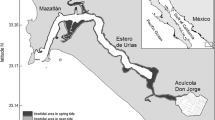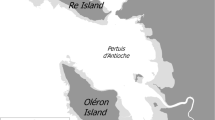Abstract
We present data on the low-tide distribution of shorebirds in the Tagus estuary, Portugal, and relate the distribution of the bird assemblage with environmental factors. The study was based on an extensive survey of the majority of the intertidal flats, carried out with a high spatial resolution. The environmental factors that mostly affected the distribution of shorebirds were the exposure period, the type of sediment and the extent of the shell banks. The feeding bird assemblage could be divided into four main groups of species, and these occupied distinct areas of the estuary. These findings imply that maintaining the overall value of the estuaries for foraging shorebirds requires relatively extensive intertidal areas, encompassing sediment flats with the large diversity of ecological characteristics required by different species.




Similar content being viewed by others
References
ArcView. http://users.skynet.be/contourgridder/.
BirdLife International, European Bird Census Council, 2000. European Bird populations: estimates and trends. Cambridge, UK.
Braak, C. J. F. T., 1986. Canonical correspondence analysis: a new eigenvector technique for multivariate direct gradient analysis. Ecology 675: 1–1826.
Bryant, D. M., 1979. Effects of prey density and site character on estuary usage by overwintering waders (Charadrii). Estuarine and Coastal Marine Science 9: 369–384.
Calvário, J., 1984. Étude preliminaire des peuplements intertidaux (substrats meubles) de l’estuaire du Tage (Portugal) et sa cartographie. Arquivos do Museu Bocage 2: 187–206.
Dias, M. P., J. P. Granadeiro, R. C. Martins & J. M. Palmeirim, 2006. Estimating the use of tidal flats by waders: inaccuracies due to the response of birds to the tidal cycle. Bird Study 53: 32–38.
Evans, P. R., 1979. Adaptations shown by foraging shorebirds to cyclical variations in the activity and availability of their intertidal prey. In Naylor, E. & R. G. Hartnoll (eds), Cyclic Phenomena in Marine Plants and Animals. Pergamon Press, New York, 357–366.
Gauch, H. G., 1982. Multivariate analysis in Community Ecology. Cambridge University Press, Cambridge, UK.
Goss-Custard, J. D. & M. G. Yates, 1992. Towards predicting the effect of salt-marsh reclamation on feeding bird numbers on the Wash. Journal of Applied Ecology 29: 330–340.
Granadeiro, J. P., J. Andrade & J. M. Palmeirim, 2004. Modelling the distribution of shorebirds in estuarine areas using generalized additive models. Journal of Sea Research 52: 227–240.
Moreira, F., 1993. Patterns of use of intertidal estuarine areas by feeding bird assemblages: a study in the Tagus estuary (Portugal). Ardeola 40: 39–53.
Moreira, F., 1995. The winter feeding ecology of avocets Recurvirostra avosetta on intertidal areas. II. Diet and feeding mechanisms. Ibis 137: 99–108.
Moreira, F., 1999. On the use by birds of intertidal areas of the Tagus estuary: implications for management. Aquatic Ecology 33: 301–309.
Mouritsen, K. N. & K. T. Jensen, 1992. Choice of microhabitat in tactile foraging dunlins Calidris alpina: the importance of sediment penetrability. Marine Ecology Progress Series 85: 1–8.
Musgrove, A. J., R. Langton, H. Baker & R. M. Ward, 2003. Estuarine Waterbirds at low tide. The WeBS Low Tide Counts 1992–93 to 1998–99. Thetford, Wader Study Group/ British Trust for Ornithology, The Wildfowl and Wetlands Trust, Royal Society for the Protection of Birds and the Joint Nature Conservation Committee.
Oksanen, J., R. Kindt & R. B. O’Hara, 2005. vegan: Community Ecology Package version 1.6–10. http://cc.oulu.fi/jarioksa/.
Palmer, M. W., 1993. Putting things in even better order: the advantages of canonical correlation analysis. Ecology 74: 2215–2230.
R Development Core Team, 2005. R: A language and environment for statistical computing. R Foundation for Statistical Computing. http://www.R-project.org.
Rehfisch, M. M., G. E. Austin, M. J. S. Armitage, P. W. Atkinson, S.J. Holloway, A. J. Musgrove & M. S. Pollitt, 2003. Numbers of wintering waterbirds in Great Britain and the Isle of Man (1994/1995–1998/1999): II. coastal waders (Charadrii). Biological Conservation 112: 329–341.
Rosa, S., J. M. Palmeirim & F. Moreira, 2003. Factors affecting waterbird abundance and species richness in an increasingly urbanized area of the Tagus Estuary in Portugal. Waterbirds 26: 226–232.
Santos, C. D., J. P. Granadeiro & J. M. Palmeirim, 2005. Feeding ecology of Dunlin Calidris alpina in a southern european estuary. Ardeola 52: 235–252.
Scheiffarth, G., G. Nehls & I. Austen, 1996. Modelling distribution of shorebirds on tidal flats on Wadden Sea and visualisation of results with the GIS IDRISI. In Lorup, E. & J. Strobl (eds), IDRISI GIS 96: Salzburger Geographische Materialien, Vol 25. Selbsiverlag des Instituts für Geographie der Universitat Salzburg. http://www.clarklabs.org/10applic/idr96cd/scheiff/idrisicd.html.
Stroud, D. A., N. C. Davidson, R. West, D. A. Scott, L. Haanstra, O. Thorup, B. Ganter & S. Delany, 2004. Status of migratory wader populations in Africa and Western Eurasia in the 1990s. International Wader Studies 15.
Symonds, F. L., D. R. Langslow & M. W. Pienkowski, 1984. Movements of wintering shorebirds within the Firth of Forth: species differences in usage of an intertidal complex. Biological Conservation 28: 187–215.
Teixeira, A. M., 1985. Dispersão intertidal da avifauna aquática invernante no estuário do Tejo. Serviço Nacional de Parques, Reservas e Conservação da Natureza (unpublished report) 71 pp.
Venables, W. N. & B. D. Ripley, 2002. Modern applied statistics with S. 4th Edition. Springer-Verlag, New York, 495 pp.
Wolff, W. J., 1969. Distribution of non-breeding waders in an estuarine area in relation to the distribution of their food organisms. Ardea 57: 1–28.
Yates, M. G. & J. D. Goss-Custard, 1991. A comparison between high-water and low-water counts of shorebirds on the Wash, east England. Bird Study 38: 179–187.
Yates, M. G., J. D. Goss-Custard, S. McGrorty, K. H. Lakhani, S. E. A. Durell, R. T. Clarke, W. E. Rispin, I. Moy, T. Yates, R. A. Plant & A. J. Frost, 1993. Sediment characteristics, invertebrate densities and shorebird densities on the inner banks of the Wash. Journal of Applied Ecology 30: 599–614.
Zwarts, L., A. M. Blomert & J. H. Wanink, 1992. Annual and seasonal variation in the food supply harvestable by knot Calidris canutus staging in the Wadden Sea in late summer. Marine Ecology Progress Series 83: 129–139.
Zweers, G., F. Jong, H. Berkhoudt & J. C. V. Berge, 1995. Filter feeding in flamingos (Phoenicopterus ruber). Condor 97: 297–324.
Acknowledgements
We thank the many volunteers who provided assistance during fieldwork. We are particularly grateful to Ana Tavares, Ricardo C. Martins and Susana L. Rosa for their continuing support. Two anonymous referees offered useful and constructive comments. This work was funded by Fundação para a Ciência e a Tecnologia, through research projects Sat-Tagis (Contract POCTI/C/MAR/15256/1999) and Pred-Tagis (POCTI/POCTI/BSE/47569/2002), both co-financed by the ERDF and grant SFRH/BPD/11544/2002 to JPG.
Author information
Authors and Affiliations
Corresponding author
Rights and permissions
About this article
Cite this article
Granadeiro, J.P., Santos, C.D., Dias, M.P. et al. Environmental factors drive habitat partitioning in birds feeding in intertidal flats: implications for conservation. Hydrobiologia 587, 291–302 (2007). https://doi.org/10.1007/s10750-007-0692-8
Issue Date:
DOI: https://doi.org/10.1007/s10750-007-0692-8




